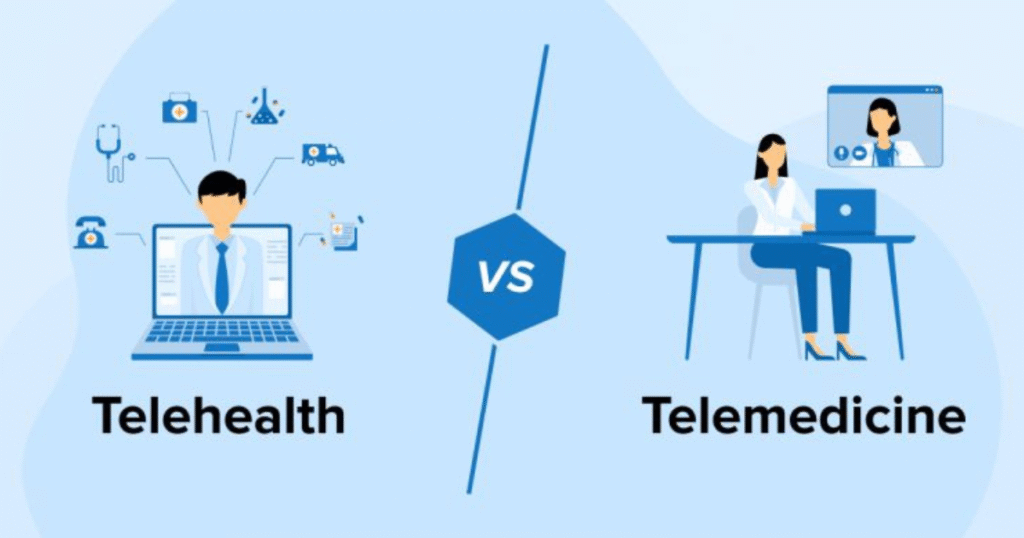In today’s fast-paced digital world, healthcare is undergoing a major transformation. One of the most revolutionary changes is the rise of telemedicine, a modern approach that uses technology to provide healthcare services remotely. Especially since the global pandemic, telemedicine has become a vital tool in ensuring continuous patient care while minimizing physical contact.
This guide will help you understand what telemedicine is, how it works, its benefits and challenges, and what the future holds for this rapidly growing field.
Understanding Telemedicine
What Is Telemedicine?
Telemedicine refers to the practice of using digital communication tools—such as video calls, phone calls, emails, and mobile apps—to deliver healthcare services remotely. It enables patients to consult doctors, receive diagnoses, and even get prescriptions without visiting a medical facility in person.
Originally developed to help people in rural or underserved areas access healthcare, telemedicine has now become mainstream across the globe, making healthcare more accessible, efficient, and convenient.
Telemedicine vs Telehealth

Although often used interchangeably, telemedicine is a subset of telehealth. While telemedicine specifically refers to clinical services provided remotely, telehealth encompasses a broader range of services including administrative meetings, continuing medical education, and patient monitoring.
How Telemedicine Works
Telemedicine uses various technologies and platforms to connect healthcare providers with patients. Here’s a breakdown of how it typically works:
Step 1: Scheduling the Appointment
Patients can schedule a telemedicine appointment through a hospital website, app, or third-party telehealth platform. Some services also allow walk-in virtual consultations.
Step 2: Virtual Consultation
At the scheduled time, the patient connects with the doctor through a secure video conferencing system. During the consultation, the doctor can discuss symptoms, ask questions, and visually examine certain conditions.
Step 3: Diagnosis and Treatment
Based on the information provided, the doctor may offer a diagnosis and recommend treatment. In many cases, they can send electronic prescriptions directly to a pharmacy.
Step 4: Follow-Up and Monitoring
Many platforms support follow-up consultations and remote monitoring, especially for chronic illnesses or post-surgery care. Some use wearable devices to track vital signs and share data with the provider in real-time.
Types of Telemedicine
There are several forms of telemedicine that serve different medical purposes:
1. Real-Time Interactive Services
This is the most common type and includes live video consultations where patients and doctors interact in real time.
2. Store-and-Forward
Also known as asynchronous telemedicine, this method allows the transmission of medical data (like X-rays or lab results) to a specialist for review at a later time.
3. Remote Patient Monitoring (RPM)
This involves the use of connected devices like blood pressure monitors or glucose meters to track a patient’s health remotely and alert providers of any issues.
4. Mobile Health (mHealth)
Apps and wearable devices that track fitness, monitor health, or send medication reminders also fall under the telemedicine umbrella.
Benefits of Telemedicine
Telemedicine offers numerous advantages to both patients and healthcare providers.
For Patients
- Convenience: No need to travel, wait in clinics, or take time off work.
- Accessibility: Ideal for patients in rural or remote areas with limited healthcare facilities.
- Cost-Effective: Reduces travel and in-person consultation costs.
- Timely Care: Immediate access to care, especially for minor ailments or follow-ups.
- Better Management of Chronic Diseases: With RPM and regular follow-ups, chronic illness management becomes more efficient.
For Providers
- Increased Reach: Doctors can consult with more patients, regardless of location.
- Operational Efficiency: Reduces overhead costs and streamlines workflows.
- Reduced No-Show Rates: Patients are more likely to attend virtual appointments.
- Improved Patient Engagement: Easy follow-ups and check-ins promote better care adherence.
Challenges and Limitations
Despite its many advantages, telemedicine comes with a few challenges:
Technology Barriers
Patients or providers may lack the required devices, internet connectivity, or technical literacy to use telemedicine platforms effectively.
Privacy and Security Concerns

Sharing medical information online raises concerns about data breaches and HIPAA compliance. Ensuring secure platforms is critical.
Limited Physical Examination
Some conditions require hands-on physical examination, lab work, or imaging, which cannot be done virtually.
Licensing and Regulations
Doctors often need to be licensed in the state where the patient resides, which can restrict interstate care.
Insurance and Reimbursement
Although telemedicine coverage is expanding, not all insurance plans reimburse virtual visits at the same rate as in-person care.
Common Conditions Treated Through Telemedicine
Telemedicine is best suited for non-emergency, general, and follow-up care. Common issues treated include:
- Cold and flu symptoms
- Allergies and asthma
- Skin conditions (rashes, acne, eczema)
- Mental health and counseling
- Urinary tract infections
- Diabetes management
- Medication adjustments
- Minor injuries and infections
Telemedicine in Specialties
Telemedicine has seen growing use in various medical specialties, including:
Mental Health (Telepsychiatry)
One of the most successful telemedicine applications, especially for therapy, medication management, and mental health assessments.
Dermatology (Teledermatology)
High-resolution images can be sent to dermatologists for evaluation, reducing wait times for appointments.
Cardiology
Remote monitoring devices help track heart rate, blood pressure, and detect arrhythmias, providing real-time data to cardiologists.
Pediatrics
Telemedicine helps parents get quick consultations for their children without exposing them to clinic germs.
Geriatrics
Older adults benefit from home consultations, especially those with mobility or transportation issues.
Telemedicine Technology and Tools
Telemedicine is powered by a variety of tools and platforms that ensure seamless communication and accurate diagnosis.
Video Conferencing Software
Platforms like Zoom for Healthcare, Doxy.me, and Teladoc provide HIPAA-compliant video chat functionality for virtual visits.
Wearable Devices
Smartwatches, glucose monitors, heart rate trackers, and other wearable tech help with real-time health monitoring.
EHR Integration
Modern telemedicine platforms integrate with Electronic Health Records (EHR) to streamline patient history access, documentation, and prescription management.
AI and Chatbots
AI-driven chatbots can pre-screen symptoms, schedule appointments, and provide patient education before and after a virtual visit.
The Future of Telemedicine
The future of telemedicine looks promising, with innovation driving better accessibility, precision, and integration.
Expansion of AI and Remote Diagnostics
AI will enhance diagnostic accuracy and improve workflow automation, reducing physician burnout.
Improved Access for Rural Areas
With 5G and better internet infrastructure, rural and remote areas will experience enhanced access to care.
Virtual Reality (VR) and Augmented Reality (AR)

In the future, VR and AR could be used for physical therapy, surgical planning, and patient education.
Broader Insurance Coverage
More insurance providers are recognizing the value of telehealth and expanding coverage, making virtual visits more affordable.
How to Prepare for a Telemedicine Appointment
To make the most of your virtual visit, follow these steps:
1. Choose a Quiet and Private Location
Ensure your environment is quiet and well-lit, with no distractions during the consultation.
2. Test Your Equipment
Check your camera, microphone, and internet connection before the appointment.
3. Have Medical Info Ready
Prepare a list of symptoms, medications, allergies, and medical history to share with your provider.
4. Write Down Questions
Have a list of questions or concerns to discuss during the consultation.
5. Follow Up
Ask about the next steps, whether you need tests, prescriptions, or a follow-up appointment.
Also Read :Diagnosis Tools: A Backbone Of Modern Medical Practice
Conclusion
Telemedicine is not just a temporary solution—it’s a critical evolution in healthcare delivery. From convenience and cost-effectiveness to expanded access and better chronic care management, telemedicine has already changed the way we approach medical services. As technology continues to evolve, so will the scope and efficiency of virtual healthcare.
By understanding what telemedicine is, how it works, and its benefits and challenges, patients and providers alike can embrace this powerful tool to improve health outcomes and transform the future of care.
FAQs
1. What is telemedicine?
Telemedicine is the remote diagnosis and treatment of patients using telecommunications technology like video calls, apps, and phones.
2. Is telemedicine safe and secure?
Yes, reputable platforms use encrypted communication and follow HIPAA regulations to protect patient privacy and data.
3. Can prescriptions be provided through telemedicine?
Yes, in most cases, healthcare providers can send e-prescriptions to your preferred pharmacy after a virtual consultation.
4. Do insurance companies cover telemedicine?
Many insurance providers now cover telemedicine services, though coverage may vary by plan and state.
5. Can all medical conditions be treated through telemedicine?
Not all. While many minor and chronic conditions can be managed remotely, emergencies and certain physical exams require in-person visits.








